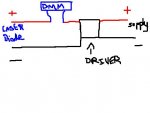Clickey
0
- Joined
- Mar 15, 2009
- Messages
- 74
- Points
- 8
Hey, I was thinking of building a new PHR-803T Blu-Ray laser pointer, but I want to get it as long life as possible. I have a few questions.
1. Can the DDL Circuit (if equipped with a 1000-ohm variable resistor instead of a 100 ohm) maintain an out-put of 120mA?
2. What is the preferred mA and mV reading for a PHR-803T Blu-Ray laser diode?
3. Must I run the circuit through a dummy load before getting my reading or could I just use the positive and negative coming from the circuit?
4. What is the recommended run time for a laser diode before it can burn out from its own heat or some other cause?
Please help me out. I only built 2 lasers both of them being the PHR lasers, but both burnt out.
1. Can the DDL Circuit (if equipped with a 1000-ohm variable resistor instead of a 100 ohm) maintain an out-put of 120mA?
2. What is the preferred mA and mV reading for a PHR-803T Blu-Ray laser diode?
3. Must I run the circuit through a dummy load before getting my reading or could I just use the positive and negative coming from the circuit?
4. What is the recommended run time for a laser diode before it can burn out from its own heat or some other cause?
Please help me out. I only built 2 lasers both of them being the PHR lasers, but both burnt out.






